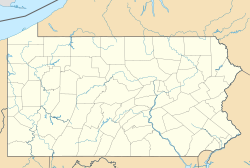Schaeffer House | |
 Schaeffer House, November 2011 | |
| Location | 213 S. Carpenter St., Schaefferstown, Heidelberg Township, Pennsylvania |
|---|---|
| Coordinates | 40°17′47″N76°18′1″W / 40.29639°N 76.30028°W |
| Area | less than one acre |
| Built | c. 1736, c. 1771 |
| Architectural style | Colonial, Germanic |
| Part of | Brendle Farms (ID72001130) |
| NRHP reference No. | 11000630 [1] |
| Significant dates | |
| Added to NRHP | July 25, 2011 |
| Designated CP | July 24, 1972 |
The Alexander Schaeffer House is a historic house museum at 213 South Carpenter Road in Schaefferstown, Heidelberg Township, Lebanon County, Pennsylvania. Built about 1736 and enlarged in 1771, it is a rare example of an 18th-century colonial German-style Weinbauernhouse (transliterated from German as "winemaker's house"), in which a residence and the production of alcohol products are combined in a single building. [2] The house is on the upper Brendle Farms property of Historic Schaefferstown, which offers tours of the house by appointment. It was designated a National Historic Landmark in 2011. [1]



